Unit 4 Stories and poems Lesson 20 Say It in Five课件(共28张PPT)
文档属性
| 名称 | Unit 4 Stories and poems Lesson 20 Say It in Five课件(共28张PPT) | 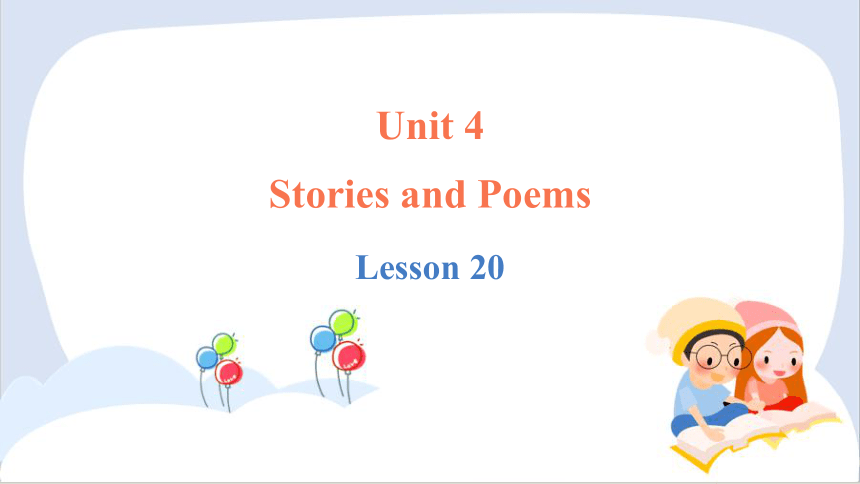 | |
| 格式 | pptx | ||
| 文件大小 | 2.9MB | ||
| 资源类型 | 教案 | ||
| 版本资源 | 冀教版 | ||
| 科目 | 英语 | ||
| 更新时间 | 2024-07-26 15:03:53 | ||
图片预览

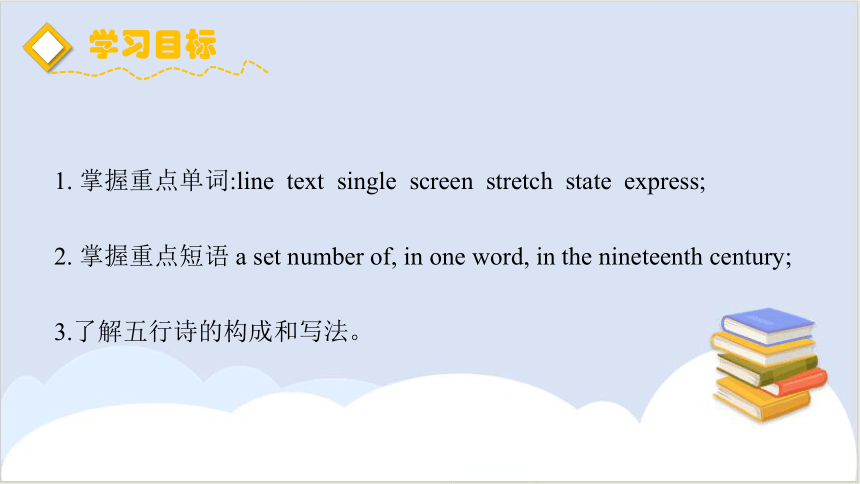
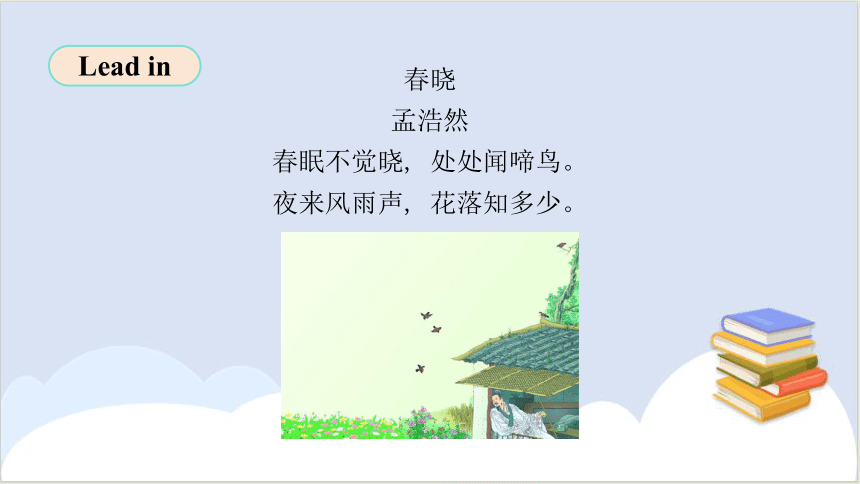

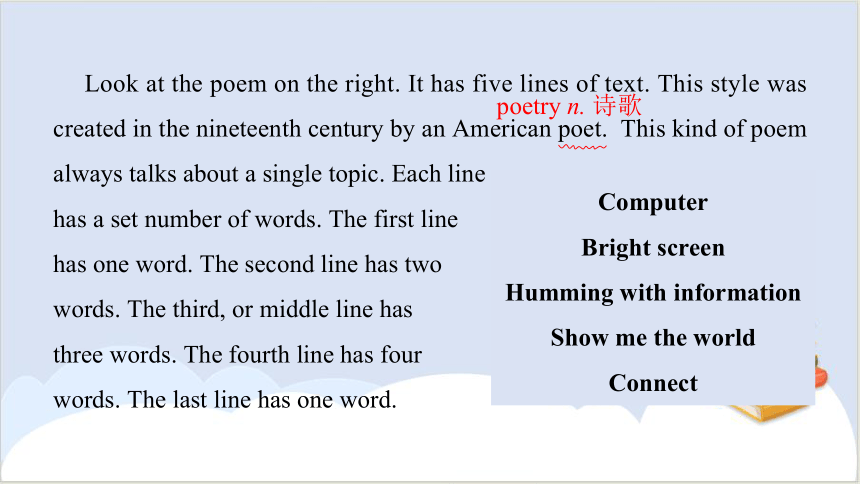
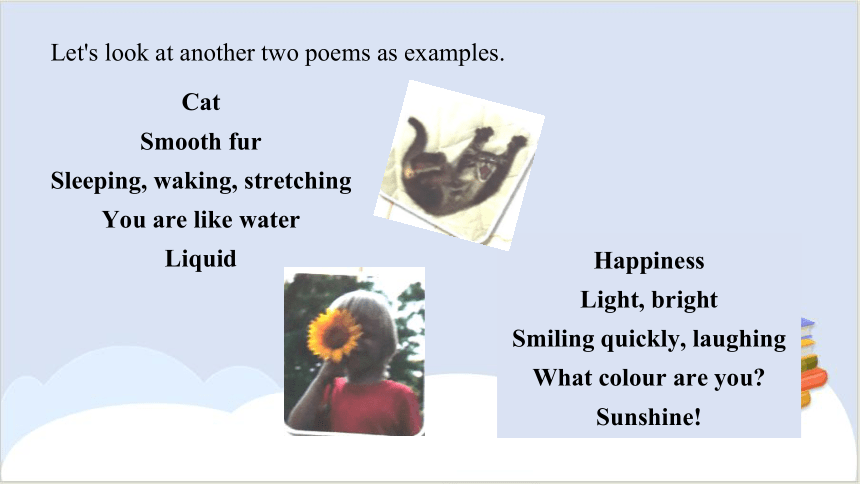

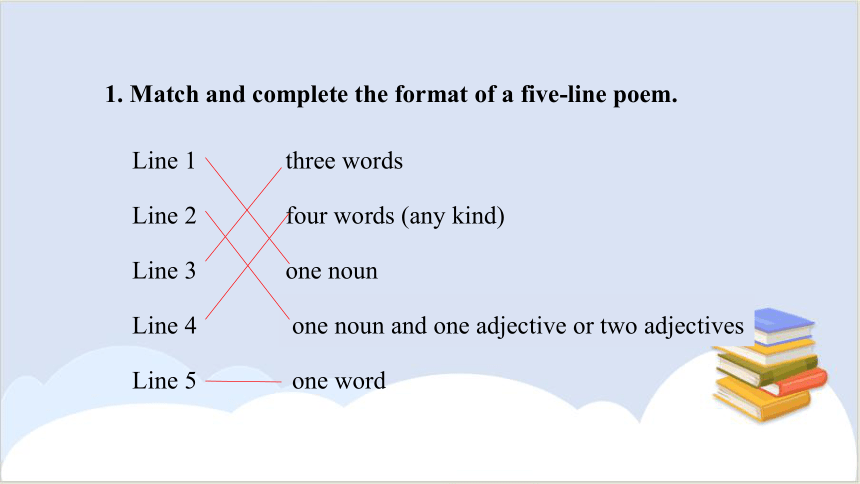
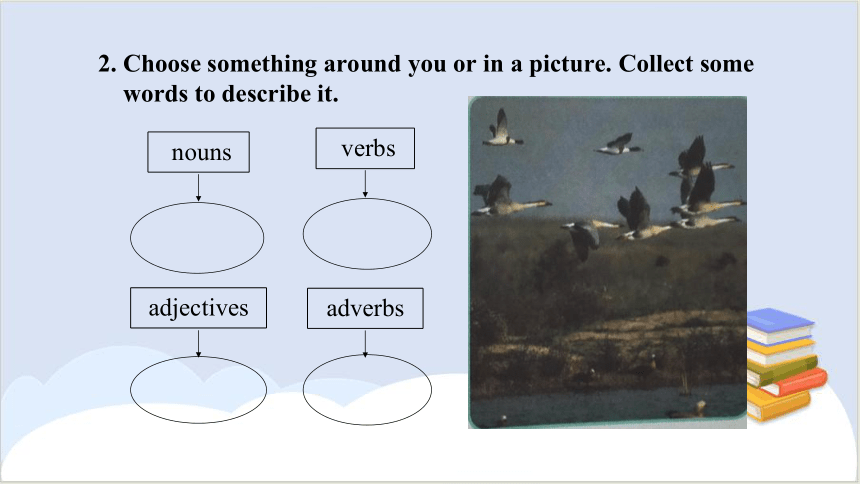
文档简介
(共28张PPT)
Lesson 20
Unit 4
Stories and Poems
学习目标
1. 掌握重点单词:line text single screen stretch state express;
2. 掌握重点短语 a set number of, in one word, in the nineteenth century;
3.了解五行诗的构成和写法。
春晓
孟浩然
春眠不觉晓, 处处闻啼鸟。
夜来风雨声, 花落知多少。
Lead in
THINK ABOUT IT
·Read a few old Chinese poems. Do they follow a pattern
·What pattern does a five- line poem follow
新课讲授
Text presentation
Look at the poem on the right. It has five lines of text. This style was created in the nineteenth century by an American poet. This kind of poem always talks about a single topic. Each line
has a set number of words. The first line
has one word. The second line has two
words. The third, or middle line has
three words. The fourth line has four
words. The last line has one word.
Computer
Bright screen
Humming with information
Show me the world
Connect
poetry n. 诗歌
Cat
Smooth fur
Sleeping, waking, stretching
You are like water
Liquid
Happiness
Light, bright
Smiling quickly, laughing
What colour are you
Sunshine!
Let's look at another two poems as examples.
Here is how you can write your own five- line poem.
Line 1: In one word, state the topic of your poem. Use a noun.
Line 2: Describe your topic in two words. Use a noun and an adjective or two adjectives.
Line 3: Choose three words that describe what your topic does.
Line 4: Express a thought or a feeling about your topic in four words. You can use any type of words here.
Line 5: Say something about your topic in one word.
1. Match and complete the format of a five line poem.
Line 1
Line 2
Line 3
Line 4
Line 5
three words
four words (any kind)
one noun
one noun and one adjective or two adjectives
one word
2. Choose something around you or in a picture. Collect some words to describe it.
nouns
verbs
adjectives
adverbs
3. Work in pairs. Choose words from your word collection above in Activity 2, and write a five line poem. Share your poem with your classmates.
____________
____________ ____________
____________ ____________ ____________
____________ ____________ ____________ ____________ ____________
① What pattern does a five-line poem follow
复合形容词
e.g. This seven-year-old girl called 120 and saved her mother.
这个七岁的女孩拨打了120, 救了她的妈妈。
考点
相当于a poem of five lines,
其中five-line是复合形容词。
Language points
拓展: 表示时间或距离的复合形容词可以和名词所有格进行转换。
e.g. a three-hour drive =a three hours’ drive 三个小时的车程
复合形容词的主要特征:
构成复合形容词的每个单词之间要用连字符“-”连接, 其中的名词要用单数形式。
复合形容词通常作前置定语。
复合形容词前常有冠词、指示代词、形容词性物主代词等。
② This style was created in the nineteenth century by an American poet.
一般过去时的被动语态
考点
结构: was/were+ 及物动词的过去分词, 其后可跟“by+动作的执行者”, 意为“被……; 由……”。
e.g. Last year, many trees were planted along the streets in our city. 去年, 我们的城市沿街种了很多树。
考向
③ This kind of poem always talks about a single topic.
single /'s ɡl/ adj. 单独的; 单一的
e.g. There was not a single person in the house.
房子里一个人都没有。
He sent her a single red rose.
他送给她一支红玫瑰。
考点
single 作形容词,常在句中作定语,没有比较级和最高级形式。
e.g. Are you married or single 你已婚还是单身
A single room at the hotel costs 56 pounds per night.
这个酒店的单人间价格是56 英镑一晚。
I need two single tickets from China to Canada.
我需要两张中国到加拿大的单程票。
single 的一词多义:单身的;未婚的 单人的 单程的
④ Each line has a set number of words.
(高频) each 的用法
考点 1
辨析: each 与every
each 作形容词, 修饰可数名词的单数。表示两个或两个以上的人或物中的每一个, 强调个体。
every 作形容词, 修饰可数名词的单数。表示三个或三个以上的人或物中的每一个, 强调全体。
e.g. There are some trees on each side of the street.
街道两边都有一些树。
There are some students on every side of the playground.
操场四周有一些学生。
温馨提示:each 不能与almost, nearly或not 连用。而every 可与 almost, nearly 或not 连用。
拓展: each 作代词时, 可单独使用。也可与介词of 连用, 后接名词或代词, 谓语动词用单数形式。
e.g. Each has two apples. 每人有两个苹果。
Each of the cars was different. 每辆小汽车都是不同的。
We each eat an egg. 我们每人吃一个鸡蛋。
放在复数主语后,作同位语
a set number of 一定数量的
e.g. The school funds a set number of free places.
学校资助固定数目的免费生。
考点2
set 在此作形容词 ,意为“固定的;确定的”。a set number of 后接可数名词复数。
辨析: a number of 与the number of
a number of 指“若干; 许多”。“a number of+ 可数名词的复数形式”作主语, 谓语动词要用复数形式。
the number of 指“……的数量”。“the number of+ 可数名词的复数形式”作主语, 谓语动词要用单数形式。
⑤ Let’s look at another two poems as examples.
(重点) another det. & pron. 又一; 再一
another 通常用于三个(或三个以上) 的任意一个人或物, 意为“又一; 再一”。
(1) another+ 可数名词单数=one more+ 可数名词单数。
e.g. Would you like another cup of tea
=Would you like one more cup of tea
你想再来杯茶吗
考点
考向
(2) another+ 基数词(大于1) + 复数名词= 基数词(大于1) +more+ 复数名词。
e.g. Can you give me another ten books
=Can you give me ten more books
你能再给我十本书吗
拓展: another 还可作代词, 意为“另一个”, 通常泛指同类事物中的另一个。
e.g. I got another of those calls yesterday.
昨天我又接了一个那样的电话。
温馨提示:another多位于数词之前;more 与数词连用时,多位于其后。
⑥ In one word, state the topic of your poem.
state /ste t/ v. 陈述; 说明
e.g. State your name and address, please.
请说明你的姓名和地址。
The room was in a very dirty state. 房间里非常脏。
The government makes a statement.
政府发表了一个声明。
考点
近义词:explain v.说明;解释
state 的名词形式,意为“陈述;声明”。
state 一词多义:n.状况;情况 n.国家;州
⑦ Express a thought or a feeling about your topic in four words.
express / k'spres/ v. 表达
e.g. He expressed his views to everyone at the meeting.
会议上他向大家表达了他的观点。
The art world gave me a chance to express myself without words.
艺术世界给了我一个不用语言来表达自我的机会。
考点
express sth. to sb.
向某人表达某事
express oneself
表达自己的思想
Laughter is one of the most infectious expressions of emotion. 笑是最具感染力的情感表达方式之一。
express 的名词形式,意为“表示;表达”。
expression 的发音以元音音素开头,前面有不定冠词时,应用an。
本节课主要学习了:
重点单词: single, each, state, express, 以及复合形容词构词法five-line等。
重点短语: in the nineteenth century, a set number of; another two等。
课堂总结
当堂检测
一、根据句意及汉语提示完成单词
1.Please use an adjective to ________(表达)your feeling now.
2.This computer's ________(屏幕)is very clear.
3.Can you ________(陈述)the main idea of this text
4. She wants to have a ________(单独的)room because
she doesn't like living with any other people.
5. Read the second________(行) of the ________ (正文)
and find out the answer to the question.
express
screen
state
single
line
text
二、单项选择
6.Reading a large number of books ________ make us wiser.
The more we read, the more we know.
A.can B.would C.need
7.Each book has ________ new words.
A.number of B.the number of
C.the set number of D.a set number of
A
D
Lesson 20
Unit 4
Stories and Poems
学习目标
1. 掌握重点单词:line text single screen stretch state express;
2. 掌握重点短语 a set number of, in one word, in the nineteenth century;
3.了解五行诗的构成和写法。
春晓
孟浩然
春眠不觉晓, 处处闻啼鸟。
夜来风雨声, 花落知多少。
Lead in
THINK ABOUT IT
·Read a few old Chinese poems. Do they follow a pattern
·What pattern does a five- line poem follow
新课讲授
Text presentation
Look at the poem on the right. It has five lines of text. This style was created in the nineteenth century by an American poet. This kind of poem always talks about a single topic. Each line
has a set number of words. The first line
has one word. The second line has two
words. The third, or middle line has
three words. The fourth line has four
words. The last line has one word.
Computer
Bright screen
Humming with information
Show me the world
Connect
poetry n. 诗歌
Cat
Smooth fur
Sleeping, waking, stretching
You are like water
Liquid
Happiness
Light, bright
Smiling quickly, laughing
What colour are you
Sunshine!
Let's look at another two poems as examples.
Here is how you can write your own five- line poem.
Line 1: In one word, state the topic of your poem. Use a noun.
Line 2: Describe your topic in two words. Use a noun and an adjective or two adjectives.
Line 3: Choose three words that describe what your topic does.
Line 4: Express a thought or a feeling about your topic in four words. You can use any type of words here.
Line 5: Say something about your topic in one word.
1. Match and complete the format of a five line poem.
Line 1
Line 2
Line 3
Line 4
Line 5
three words
four words (any kind)
one noun
one noun and one adjective or two adjectives
one word
2. Choose something around you or in a picture. Collect some words to describe it.
nouns
verbs
adjectives
adverbs
3. Work in pairs. Choose words from your word collection above in Activity 2, and write a five line poem. Share your poem with your classmates.
____________
____________ ____________
____________ ____________ ____________
____________ ____________ ____________ ____________ ____________
① What pattern does a five-line poem follow
复合形容词
e.g. This seven-year-old girl called 120 and saved her mother.
这个七岁的女孩拨打了120, 救了她的妈妈。
考点
相当于a poem of five lines,
其中five-line是复合形容词。
Language points
拓展: 表示时间或距离的复合形容词可以和名词所有格进行转换。
e.g. a three-hour drive =a three hours’ drive 三个小时的车程
复合形容词的主要特征:
构成复合形容词的每个单词之间要用连字符“-”连接, 其中的名词要用单数形式。
复合形容词通常作前置定语。
复合形容词前常有冠词、指示代词、形容词性物主代词等。
② This style was created in the nineteenth century by an American poet.
一般过去时的被动语态
考点
结构: was/were+ 及物动词的过去分词, 其后可跟“by+动作的执行者”, 意为“被……; 由……”。
e.g. Last year, many trees were planted along the streets in our city. 去年, 我们的城市沿街种了很多树。
考向
③ This kind of poem always talks about a single topic.
single /'s ɡl/ adj. 单独的; 单一的
e.g. There was not a single person in the house.
房子里一个人都没有。
He sent her a single red rose.
他送给她一支红玫瑰。
考点
single 作形容词,常在句中作定语,没有比较级和最高级形式。
e.g. Are you married or single 你已婚还是单身
A single room at the hotel costs 56 pounds per night.
这个酒店的单人间价格是56 英镑一晚。
I need two single tickets from China to Canada.
我需要两张中国到加拿大的单程票。
single 的一词多义:单身的;未婚的 单人的 单程的
④ Each line has a set number of words.
(高频) each 的用法
考点 1
辨析: each 与every
each 作形容词, 修饰可数名词的单数。表示两个或两个以上的人或物中的每一个, 强调个体。
every 作形容词, 修饰可数名词的单数。表示三个或三个以上的人或物中的每一个, 强调全体。
e.g. There are some trees on each side of the street.
街道两边都有一些树。
There are some students on every side of the playground.
操场四周有一些学生。
温馨提示:each 不能与almost, nearly或not 连用。而every 可与 almost, nearly 或not 连用。
拓展: each 作代词时, 可单独使用。也可与介词of 连用, 后接名词或代词, 谓语动词用单数形式。
e.g. Each has two apples. 每人有两个苹果。
Each of the cars was different. 每辆小汽车都是不同的。
We each eat an egg. 我们每人吃一个鸡蛋。
放在复数主语后,作同位语
a set number of 一定数量的
e.g. The school funds a set number of free places.
学校资助固定数目的免费生。
考点2
set 在此作形容词 ,意为“固定的;确定的”。a set number of 后接可数名词复数。
辨析: a number of 与the number of
a number of 指“若干; 许多”。“a number of+ 可数名词的复数形式”作主语, 谓语动词要用复数形式。
the number of 指“……的数量”。“the number of+ 可数名词的复数形式”作主语, 谓语动词要用单数形式。
⑤ Let’s look at another two poems as examples.
(重点) another det. & pron. 又一; 再一
another 通常用于三个(或三个以上) 的任意一个人或物, 意为“又一; 再一”。
(1) another+ 可数名词单数=one more+ 可数名词单数。
e.g. Would you like another cup of tea
=Would you like one more cup of tea
你想再来杯茶吗
考点
考向
(2) another+ 基数词(大于1) + 复数名词= 基数词(大于1) +more+ 复数名词。
e.g. Can you give me another ten books
=Can you give me ten more books
你能再给我十本书吗
拓展: another 还可作代词, 意为“另一个”, 通常泛指同类事物中的另一个。
e.g. I got another of those calls yesterday.
昨天我又接了一个那样的电话。
温馨提示:another多位于数词之前;more 与数词连用时,多位于其后。
⑥ In one word, state the topic of your poem.
state /ste t/ v. 陈述; 说明
e.g. State your name and address, please.
请说明你的姓名和地址。
The room was in a very dirty state. 房间里非常脏。
The government makes a statement.
政府发表了一个声明。
考点
近义词:explain v.说明;解释
state 的名词形式,意为“陈述;声明”。
state 一词多义:n.状况;情况 n.国家;州
⑦ Express a thought or a feeling about your topic in four words.
express / k'spres/ v. 表达
e.g. He expressed his views to everyone at the meeting.
会议上他向大家表达了他的观点。
The art world gave me a chance to express myself without words.
艺术世界给了我一个不用语言来表达自我的机会。
考点
express sth. to sb.
向某人表达某事
express oneself
表达自己的思想
Laughter is one of the most infectious expressions of emotion. 笑是最具感染力的情感表达方式之一。
express 的名词形式,意为“表示;表达”。
expression 的发音以元音音素开头,前面有不定冠词时,应用an。
本节课主要学习了:
重点单词: single, each, state, express, 以及复合形容词构词法five-line等。
重点短语: in the nineteenth century, a set number of; another two等。
课堂总结
当堂检测
一、根据句意及汉语提示完成单词
1.Please use an adjective to ________(表达)your feeling now.
2.This computer's ________(屏幕)is very clear.
3.Can you ________(陈述)the main idea of this text
4. She wants to have a ________(单独的)room because
she doesn't like living with any other people.
5. Read the second________(行) of the ________ (正文)
and find out the answer to the question.
express
screen
state
single
line
text
二、单项选择
6.Reading a large number of books ________ make us wiser.
The more we read, the more we know.
A.can B.would C.need
7.Each book has ________ new words.
A.number of B.the number of
C.the set number of D.a set number of
A
D
同课章节目录
- Unit 1 Stay Healthy
- Lesson 1 What's Wrong,Danny?
- Lesson 2 A Visit to the Dentist
- Lesson 3 Good Food, Good Health
- Lesson 4 Don't Smoke, Please!
- Lesson 5 Jane's Lucky Life
- Lesson 6 Stay Away from the Hospital
- Unit Review
- Unit 2 Great People
- Lesson 7 What Is the Meaning of Lift?
- Lesson 8 A Universe of Thought
- Lesson 9 China's Most Famous "Farmer"
- Lesson 10 Touch the World
- Lesson 11 To China, with Love
- Lesson 12 Guess My Hero!
- Unit Review
- Unit 3 Safety
- Lesson 13 Be Careful,Danny!
- Lesson 14 Accidents Happen
- Lesson 15 My Helmet Saved My Life!
- Lesson 16 How Safe Is Your Home?
- Lesson 17 Staying Safe in an Earthquake
- Lesson 18 Never Catch a Dinosaur
- Unit Review
- Unit 4 Stories and poems
- Lesson 19 A Story or a Poem?
- Lesson 20 Say It in Five
- Lesson 21 The Fable of the Woodcutte
- Lesson 22 The Giant(Ⅰ)
- Lesson 23 The Giant(Ⅱ)
- Lesson 24 Writing a Poem
- Unit Review
- Unit 5 Look into Science
- Lesson 25 Let's Do an Experiment!
- Lesson 26 Keep the Candle Burning
- Lesson 27 Planet Danny
- Lesson 28 The Study of Living Things
- Lesson 29 DNA—The Story of You
- Lesson 30 Science Affects Us
- Unit Review
- Unit 6 Movies and Theate
- Lesson 31 A movie or a Play
- Lesson 32 Moving Pictures
- Lesson 33 The Fisherman and the Goldfish(Ⅰ)
- Lesson 34 The Fisherman and the Goldfish(Ⅱ)
- Lesson 35 Theatres Are Fun!
- Lesson 36 Making Plays Is Fun
- Unit Review
